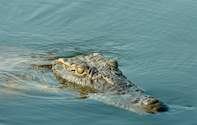
The remains of 30 dead crocodile were found by rangers and scientists along the Olifants and Sabi Rivers in the park in 2009. The mysterious crocodile killer that killed 170 crocodile in 2008, struck again. Helicopter surveys showed that were a total of 385 crocodiles in the Olifants Gorge and lower Letaba River by late 2009.
"Our research has shown that these crocodile mortalities are now a recurrent problem that is likely to occur every winter. If mortalities continue at this rate, there will be very few crocodiles in the lower Olifants and Letaba rivers by 2010," added SANParks' head of department: scientific services, Danie Pienaar. Following these latest deaths, KNP researchers and rangers called for more collaborative efforts to ensure that South African rivers are clear of pollution.
"It is unlikely that management actions which are taken inside the KNP can solve this problem. One would need a much larger and overarching restoration program for the entire Olifants River system, which should focus on issues such as acid mine drainage, agricultural pesticides and fertiliser use, sewerage treatment and industrial and household sources of pollution," said Pienaar.During May 2008, crocodiles in the Olifants River gorge in the Kruger National Park started dying, with a mortality rate of 20 crocodiles per week reached during June and July. A total of 170 crocodile carcasses had been recorded by late November 2008. Post mortem examinations revealed yellow-orange coloured, hardened fat in the tails and abdomen - a condition known as Pansteatitis.
Change of Waters
Researchers analysed water, sediments, fish and crocodile tissue samples for potential toxins and chemical compounds at laboratories, both locally and around the world. Although many heavy metals, agricultural pesticides, fertilizers, organic waste and persistent organic pollutants (POPs) were detected, none were found to be above levels where adverse effects are expected and were therefore not individually responsible for poisoning the crocodiles.
An initiative, known as the Consortium for the Restoration of the Olifants Catchment (CROC) was established in order to build a clear cause-effect relationship and it became increasingly clear that the death of all these crocodiles was symptomatic of serious and growing environmental problems in the Olifants River system.
This multi-institutional collaborative research program includes representatives from SANParks, national government departments, including the Department of Water & Environmental Affairs, CSIR, research organisations, universities, independent consultants, NGOs and the Water Research Commission.|
CROCs research focus centred on further analysis of the water and sediment, fish pathology, water chemistry and algal composition of the river water, the population dynamics of the crocodiles in the Olifants and Letaba river systems, clinical blood parameters of the affected crocodiles in comparison to unaffected crocodiles, invertebrate and fish population dynamics and research into populations of fish-eating birds.
Some of the findings have included the fact that invertebrate species numbers have halved compared to 20 years ago, the river has changed from being a free-flowing river with diverse habitats to a standing water body thanks to the back-flooding caused by the raised Massingir Dam wall in Mozambique, numerous pollutants are present in the water and sediment although the levels of these pollutants are relatively low, toxic blue-green algae (Microcystis spp) and dinoflagellate (Ceratium spp) which cause red-tide in marine environments are present.
Fish species such as barbell (Clarias gariepinus) show hyperplastic pale gills, liver pathology and some show signs of steatitis in their fat and the fact that crocodiles in the Olifants River already show lower levels of antioxidants than crocodiles found in other water sources. "We will continue to burn all crocodile carcasses that we find as this seems to limit the spread of disease and will also continue our monitoring of the crocodile populations which includes marking crocodiles with VHF download transmitters, colour-coded tags and both daytime aerial surveys and night spotlight counts.
Long term water quality data, collected as part of DWEA's national monitoring programs, will be evaluated to facilitate a better understanding of the status quo of the Olifants River. These monitoring programs include the National Toxicity Monitoring Programme, National Chemical Monitoring Programme and the National Eutrophication Monitoring Programme, amongst others," said Pienaar.Pienaar concluded by saying that the crocodiles dying in the KNP are a clear alarm call that we can not continue to pollute our water sources as we have done for the past several decades.In 2010 only 10 crocodiles died and the numbers continued to decrease, with only 5 reported dead in 2011and four in 2012.
 Considerable variation exists throughout the range of the Nile Crocodile. Generally, it is a large crocodilian, averaging 5 m in length but ...
Considerable variation exists throughout the range of the Nile Crocodile. Generally, it is a large crocodilian, averaging 5 m in length but ...